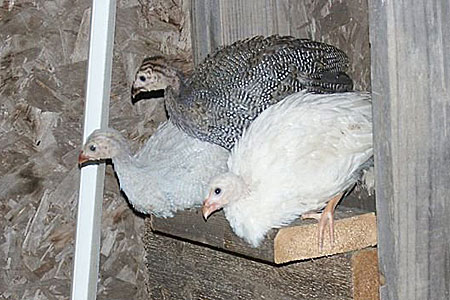
If you raise guinea fowl that you plan to free range, start with keets rather than full-grown birds. Keets become acquainted with their home ground as they broaden their foraging range. Adult guineas, on the other hand, are notorious for flying the coop the first chance they get. By raising guinea fowl from keets you have a much better chance they will stick around as they mature.
Guinea Keets
Guinea fowl come in numerous colors ranging from pure white to royal purple. The most common plumage color is pearl, so named because the gray feathers are covered with white pearl-size dots.
The word keet, in reference to a baby guinea, comes from the old Nordic word cytling (keetling), meaning a young animal. Keets are energetic little birds with beady black eyes, and bright coral beaks and feet. Pearl keets, and those of other dark varieties, start out with two-tone brown stripes down their backs, resembling two-legged chipmunks.
Brooding Keets
Keets are tiny and quick to escape through wire mesh as fine as one-half inch, making tight facilities essential. An excellent small-scale brooder is a stout cardboard box lined for the first few days with paper towels, and later with dried wood shavings, to keep the keets clean, warm, and dry.
Use a brooder lamp to heat the brooder. Raise or lower it as necessary to adjust the degree of warmth, letting the birds’ comfort be your guide. If they are unhappy, their persistent, shrill cries will make you think you’ve been invaded by a horde of angry crickets. When keets are content, they let you know with their musical “Me-too” call.
For the first four weeks, feed your keets a 21 to 23 percent protein game bird or turkey starter ration. If the only available feed is chick starter, supplement it with meal worms or eggs (either scrambled or boiled and mashed). After four weeks, switch to 18 percent grower ration supplemented with tender grass clippings, chopped lettuce, and other fresh greens.
Of course, always provide plenty of fresh water. To prevent the tiny keets from drowning, for the first several weeks use a drown-proof water base, then switch to a regular size chick water base.
As They Grow
Unlike baby chickens, guinea keets rarely get coccidiosis. However, during their first two weeks of life they are small and delicate, and can easily succumb to being chilled, trampled, or drowned. To avoid losing keets, keep them uncrowded. By the time they reach three weeks of age they should have at least one square foot per bird.
By the age of one month, they develop their first set of feathers. In the pearl variety, those first feathers are camouflage-brown in color. Keets as young as two weeks old start trying to fly, and soon enough will be flying out of the brooder if it doesn’t have a secure top. By the time they are two months of age gray feathers appear, letting you know your keets are fully feathered and ready to fend for themselves.
Keep Them Home
Guineas don’t like to be moved. If you move them from one place on your property to another, they quite likely will to try to return to the previous location. They’re more apt to stay put if they are moved directly from the brooder to their final coop, even if it means furnishing the coop with heat and light for the first few weeks after the move.
Once the keets have been moved to their permanent home, keep them confined for another six weeks. Then open the pophole door and let them decide if they want to go out or not. They may not venture out for the first couple of days. That’s okay — don’t chase them out.
When they do go out, they are likely to remain close to the doorway and pop back into the coop after looking around for a short time. Eventually they’ll stay out longer and venture farther as they learn the lay of the land.
As an extra measure, you might start offering them a little scratch grain each evening from the time they are first confined. After they start exploring the yard, they’ll eagerly return to the coop in the evening for their usual treat.
And that’s today’s news from the Cackle Coop.
Gail Damerow is the author of Hatching and Brooding Your Own Chicks: Chickens, Turkeys, Ducks, Geese, Guinea Fowl.

